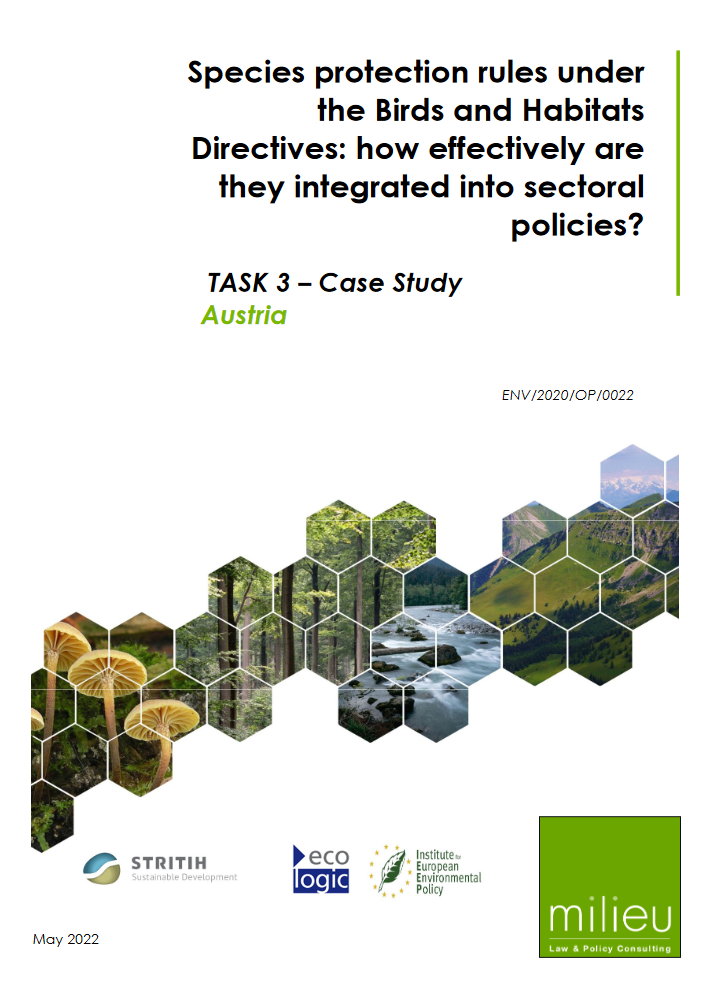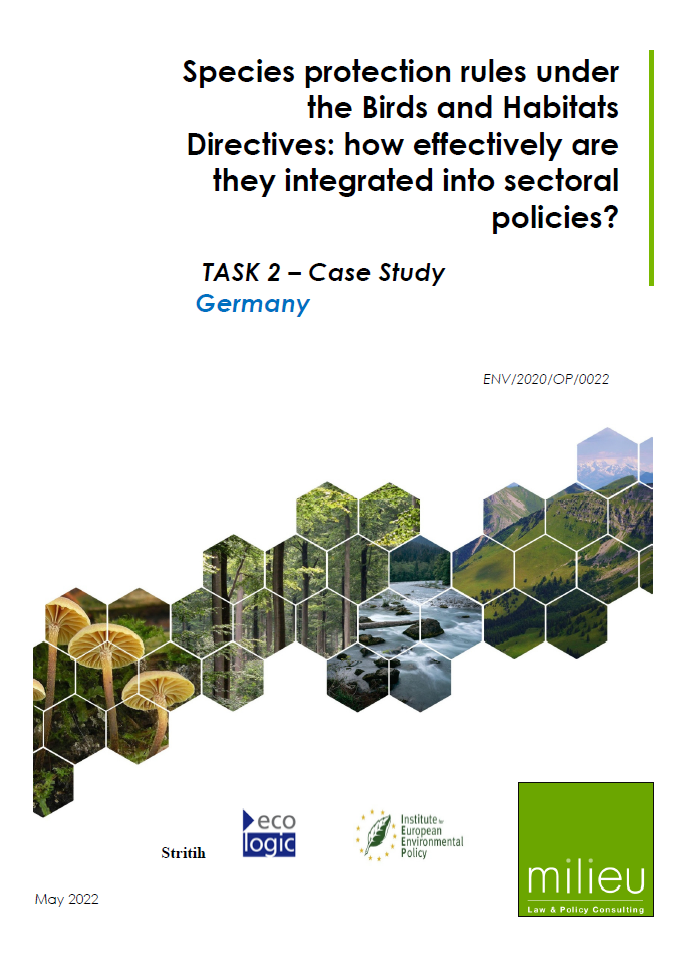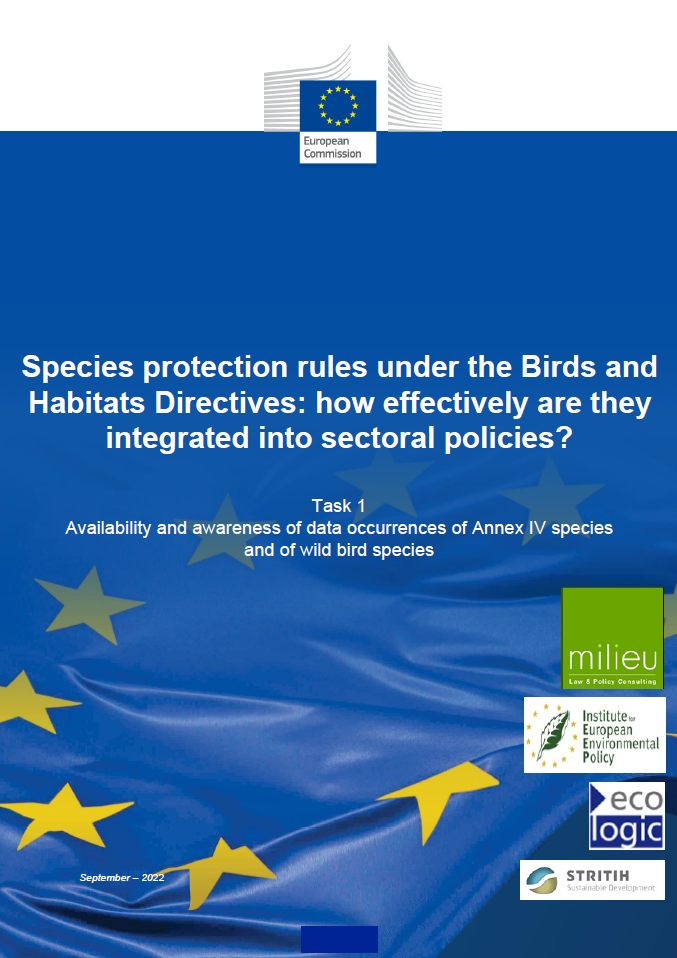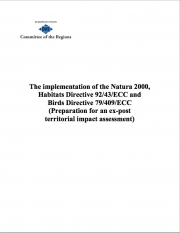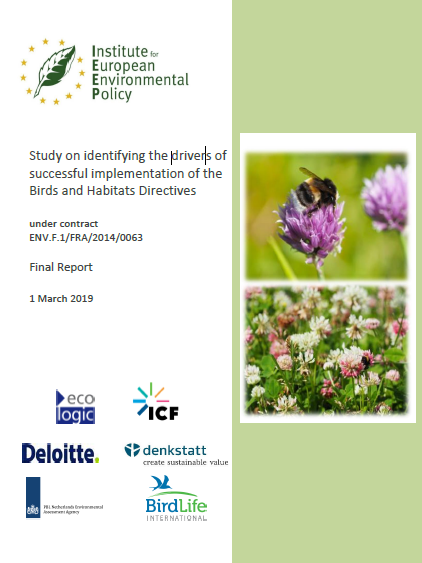Species Protection Rules under the Birds and Habitats Directives – Forestry: Country studies
- Publication
- Citation
European Commission, Directorate-General for Environment, Species protection rules under the Birds and Habitats Directives – How effectively are they integrated into sectoral policies?. Task 3, Forestry – Country studies, Publications Office of the European Union, 2022, https://data.europa.eu/doi/10.2779/360142
The Ecologic Institute, under the auspices of the EU-funded project, supported by the European Commission (DG Environment), undertook comprehensive country studies for Germany and Austria focusing on the integration of species protection rules, specifically within the forestry sector, under the Birds and Habitats Directives. The country profiles are focusing on how thoroughly the regulations are transposed into national law, to reveal what efforts are being made to provide information about them to foresters and enforce them and to evaluate assessment and authorization procedures. As for Austria and Germany, both with a federal structure, offer a detailed case of this variability. With insights from over 30 national and regional experts and a detailed look into the state of Upper Austria (Oberösterreich) for providing also insights from all other regions, where available, they offer a detailed exploration into the specific forestry practices and regulatory challenges in both countries.
Comparative Insights into Austria and Germany
The Birds and Habitats Directives (Nature Directives) are the foundations of EU nature and biodiversity policy, providing a common legal framework to conserve Europe's most threatened and valuable species and habitats. Embedded in this legislation, the protection rules for listed species apply to their entire natural range in Member States, both within and outside Natura 2000 sites. While both nations embed the Nature Directives into their legal frameworks, the variances in transposition, enforcement, and preventive measures unveil pivotal findings and recommendations in each context.
Transposition challenges
- Austria: Embeds Articles 12 and 13 HD and Article 5 BD across all states but wrestles with ambiguous exemptions and inconsistencies in interpretation and implementation, as evidenced by variations in Upper and Lower Austria.
- Germany: Through § 44 of the BNatSchG and others, translates HD and BD into national law, yet faces difficulties pertaining to broad exemptions and somewhat ambiguous legal terms, particularly in agricultural, forestry, and fisheries sectors.
Preventive measures
- Austria: Faces a deficit in legislation at the forest-level, with patchy implementation of even existing ordinances for species-specific measures, particularly in regions like Upper Austria.
- Germany: Employ strategies and management plans, supplemented with supportive landowner measures, cover 66.7% of the nation's forested area, and though tools like biotope trees enhance protection, their application isn't mandated by law.
Advisory services & enforcement
- Austria: Reveals a paucity of official guidance, limited enforcement, and broad exemptions, resulting in forestry activities often circumventing nature protection legislation.
- Germany: Presents a varied informational offering across the Länder and, while advisory services and data platforms exist, information transfer and the actual enforcement of rules, largely complaint-based, demonstrate room for significant fortification.
Authorization procedures
- Austria: Displays a limited scope of Environmental Impact Assessments (EIA) with forestry activities largely falling under Austrian Forest Law, bypassing explicit authorization and revealing silos between nature and forestry authorities.
- Germany: Showcases EIAs contingent upon specific activities and scales, lacking a direct connection to species protection rules, and revealing a complex tapestry of species protection assessments, documentation, and mapping procedures, as illustrated in regions like NRW.
Recommendations
- Austria: Efforts focus on key areas in forestry species protection. Legislative actions need to rectify transposition issues with the Birds and Habitats Directives and reassess ‘contemporary’ land use exemptions. Enhanced coordination among the Länder is critical, ensuring species protection across governance levels and enforcing obligatory management alongside voluntary measures. Advisory and enforcement should enhance species monitoring, improve access to species information, extend guidance, and strengthen advisory services. Enforcement also requires boosted compliance monitoring and capacity enhancement of entities like 'nature guards.' Moreover, authorization procedures should enhance impact assessments, particularly through improved inter-authority communication.
- Germany: Recommendations advocate for a careful revision of forestry land-use exemptions tied to species protection rules and a refinement in defining "good professional practice" in forestry. Spotlighting forest species protection at all governmental levels, strengthening mandatory management prerequisites, and amplifying regional forestry departments’ capabilities is paramount. Additionally, elevating advisory and enforcement strategies involves robust species monitoring, improving informational accessibility, and solidifying compliance controls, alongside standardizing authorization and permit procedures across all Länder.
In summary, the comprehensive analyses for both nations underscore the nuanced, yet essential alterations required to uplift the efficacy of species protection in their respective forestry sectors, thereby safeguarding biodiversity amidst industrial practices. This synthesis of findings is envisioned to foster a more informed, robust, and harmonized approach towards forestry governance, species protection, and biodiversity conservation within the frameworks of the EU Nature Directives.
Exploring pivotal insights from 12 national reports, a summary analysis unveils key challenges and best practices in implementing species protection rules in EU agriculture and forestry, guiding strategic recommendations.
